
Laura's Blog

The Kennedy Center Takeover
February 17, 2025
Amid the firehose of shocking assaults and brute-force dismantlings of federal agencies going on right now—the take-over of the Kennedy Center by Trump and his Make-America-Gross-Again cronies might seem the lesser of evils.
But we need to see it for what it is.
This is more than a petty, petulant, power-bloated man hell-bent on retribution (this time on performing artists who in the past have spoken out against his intolerance from a KenCen stage—an institution he’s never even gone to for a performance). More than a man who just can’t handle any criticism of him or his privileged-white-man’s world view or a man who’s bragged about being entitled to grab women’s genitalia and now thinks he also has the right to, in his words, eliminate “woke" art.
This is about controlling messaging, the parameters of our culture, and what thoughts/imaginings are allowed in our precious and now fragile e pluribus unum democracy. About imposing a homogeneous society, one no longer challenged by exposure to competing ideas or ways of being—a reward to followers resentful and fearful of change or the ascendance of people unlike them. A calculated move to further solidify their idolatry and loyalty of him.
It’s an authoritarian move straight out of Erdogan's take-over of Turkey. Straight out of Soviet Russia’s post-WWII Iron Curtain oppression. Straight out of a past reign of terror in our own country—when blacklists, book bans, and loyalty review boards crippled free thought and ruined the lives of thousands of Americans for years. The reign of another thin-skinned, weirdly charismatic, homophobic, sexist politician---Senator Joseph McCarthy. All wrapped in a bone-chilling ethos Trump just shouted in a tweet quoting an ego-maniacal destroyer of countries, Napoleon: “He who saves his country does not violate any law.” The sentiment feels an echo of Nixon, the last president to nearly destroy our constitutional rule of law in his power grabs, who once claimed: “When the president does it, that means it is not illegal.”
I know you’re hearing so many dire warnings right now. I take a deep breath and hug you in my heart as I say: This is one to also heed and push back on in ways I’ll describe.
One of the many gifts of writing historical/biographical fiction is perspective and gleaning some guidance of what brought out the best (or worst) in us at other pivotal moments in our journey as human beings. Let me share a few things from what has become my Cold War trilogy about the dangers of polarization, inflammatory hate-labels, and disinformation—SUSPECT RED (1950s McCarthyism), WALLS (set in 1961 Berlin, the year the infamous Wall went up), and TRUTH, LIES, AND THE QUESTIONS IN BETWEEN (1973, the year of Watergate and the struggle to ratify the ERA). My job, once as a reporter and now as an author, is to, in essence, hand you a kaleidoscope to look through, turning patchwork colors (anecdotes and facts) in your mind until they snap into a clear image you can linger on and contemplate, then interpret meaning for yourself.
I’ll start in Berlin 1961, when Soviet Russia and American troops were in a tense, toe-to-toe standoff in the city. The year Russia and its puppet East Germany raised a 27-mile barricade of barbed wire to cut the city in half and cage millions of Germans—literally overnight—without warning.
As the sun rose, many East Berliners simply stood and watched, groomed to believe through years of calculated propaganda, conspiracy theories, and censorship that such a wall was for their own protection against a “war-mongering” NATO, bent on destroying their “workers utopia.” (Not unlike Putin’s justification for invading Ukraine).





Let's contextualize disinformation and censorship:
Hitler understood disinformation to be “a truly terrible weapon.” He wrote, “the intelligence of the masses is small, but their power of forgetting is enormous. Effective propaganda must be limited to a very few points, repeated over and over in slogans, until the last member of the public understands what you want him to." One such slogan? Lugenpresse, or “fake news.”
Disinformation’s one-two punch includes censorship: banning materials deemed “to corrupt, offend, or undermine prescribed moral values.” Morals prescribed by people in power, or those who want it. Those who feel aggrieved and as if they and their ways of life are being “replaced” by lifestyles and people that offend them. Censorship prevents anything that might dilute the leader’s message: to trust him and only him, and that only certain people—his people—and his ways of living are acceptable.
In Russia-controlled East Germany, Western music was banned. Any teen caught clandestinely tuning his radio to the free-floating signal of West Berlin’s American Forces Network’s broadcasts of jazz or pop music, or somehow possessing an outlawed “barbaric” rock 'n roll record, or dancing the “bestial, vulgar, pornographic, wiggle hip” of The Twist were charged with Kulturebabarei. Culture corruption, poisoning good German morals. It was a charge akin to sedition. A charge that could send a teenager to a “re-education camp.”

Same with books. Outlawed were any stories in which characters grow through personal epiphany or empathetic revelations—an important trope of Western literature—because that didn’t reflect the power of the communist state, “the impact and nobility of a new, more humane society.”
Anything that made East Germans question the communist party-line or comforting status quo beliefs was squashed. History was sanitized to remove any truth that made their worker-citizens uneasy about themselves. They convinced East Germans that they had resisted Hitler. The fascists were in the West. Those Germans had been poisoned by the French and British, whose smug arrogance, decadence and lenient, ungodly lifestyles and art (the 1920s’ version of “woke”) had seeped across borders into western Germany, perverting them.
I wrote WALLS because I discovered in talking to them that most teens, college kids, and, heck, most adults younger than boomers, knew little about the Berlin Wall—other than it came down in 1989. Next to nothing about the horrific realities during the 28 years it stood. Little about the fanatical choking-off of free thought in East European nations that Soviet Russia had gobbled up as it liberated them from Nazis. How brutal life was behind that “Iron Curtain” (the what? I heard repeatedly).



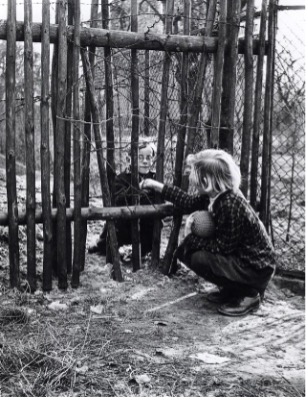
Now, let’s dip briefly into 1950s McCarthyism, our own dark hour of disinformation and censorship. It too had elicited what are you talking about? when I brought it up to students and many adults, testing whether I needed to write something about that infamous era.
Quick background: Sadly, right after WWII, the nation was primed for a fear-mongering demagogue like Joseph McCarthy. We’d just lost 400,000 Americans in that carnage. Instantly, we were in the Cold War standoff and nuclear arms race with Soviet Russia. Then, less than five years later, we were in yet another war, caused by Soviet Russia secretly giving weapons, tanks, and training to North Korea who then—without warning—invaded our ally, democratic South Korea in an aggressive land-grab. Another 40,000 Americans die.
McCarthy exploited Americans’ grief and subsequent “America-first” backlash against “other countries’ problems.” He fueled anger against “coastal elites” and “Ivy League eggheads” who advocated global politics, to ride to political celebrity and to wielding terrifying power with his Senate Committee’s investigations of “Un-American” activities.
The country and media ate up his crowd-pleasing braggadocio, his crowing that he'd do anything to catch him some Reds. Starting with his conspiracy theory claim the State Department was a deep state riddled with communists.

There’s so much to tell you about McCarthy (please see my past blog posts in Sept-Oct. 2017). Here, I’m focused on his attacking the arts and authors, musicians, playwrights, and painters as being an evil driving force of the supposed enemy within (“as sneaky and invasive and diseased in their thinking as feral fleabags.” At least, he didn’t claim they were stealing and eating family dogs.)

McCarthy was bolstered and further empowered by J. Edgar Hoover’s weaponized FBI which illegally bugged Americans he felt were out to “corrupt and confuse...each carrying the germs of death for our society...(aiming to) destroy the sanctity of the home, undermine faith in God.” And by then-V.P. Richard Nixon, another self-anointed “Red Hunter,” who alluded to any “fellow traveler” sympathetic to accused artists or people advocating for social reform as “rats.”
The fever to ban, to “otherize” and punish, to require actual oaths of loyalty to be signed to be able to work (even on independent broadcast news) spread like wildfires across the nation—to local watch-dog committees, schools and libraries, businesses, and the entertainment industry.
Blacklists were published: Like the Red Channels pamphlet , which named actors, writers, and musicians believed to spread left-wing political beliefs. Poet Langston Hughes, for instance, was vilified for corroding American values with his poems, like “Goodbye, Christ” condemned as an “example of vicious, blasphemous propaganda Communists use against religion.” People on those blacklists were fired and shunned, out of work, sometimes for years.
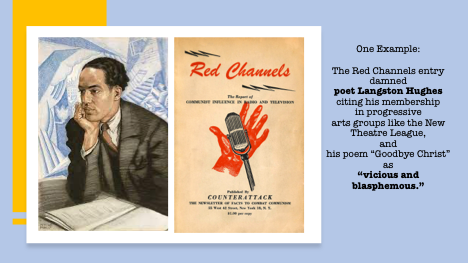
John Steinbeck’s The Grapes of Wrath, which so sensitively portrays the pain and tragedy of the Great Depression, was banned for supposedly making workers seem oppressed, that America was a hard, unfeeling place, that the rich caused the 1930s economic disaster and did little to help its victims. It made Americans feel bad about their history. It advocated socialism.
Across the nation, people ceremoniously burned Steinbeck’s masterwork in trash cans.
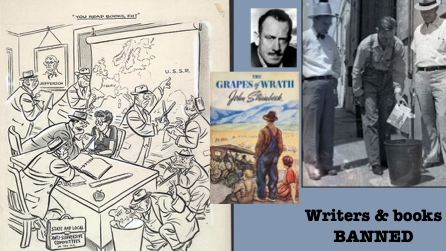
The State Department’s highly successful “cultural diplomacy” programs—nuanced attempts, not unlike our more recent USAID's humanitarian add, to woo countries susceptible to communist thought by sending musicians and art shows into Soviet Bloc countries—became suspect.
Receiving particular heat was an exhibit of abstract, expressionist, and “social realism” paintings sent to Czechoslovakia. Many of the works had been created by liberal intellectuals, refugees born in Eastern Europe. The idea was the exhibit would display—tangibly—the freedom of expression allowed in the United States, thereby refuting Soviet claims that American society was repressive. Many of the paintings depicted workers with haunting sadness or confronting Sisyphus-steep obstacles.
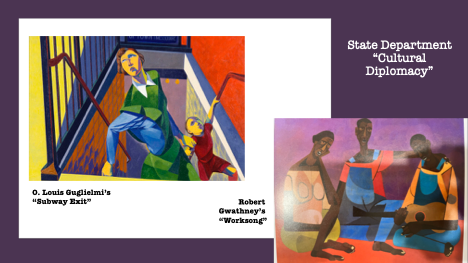
The response in Europe was overwhelmingly favorable.
But back home, conservative congressmen and radio commentators condemned the frank subject matter, dark color tones, and abstract forms as depicting American life as cruelly materialistic, in need of labor reforms (the 1950s’ version of “woke”). The exhibit was recalled. Any career diplomat involved fired.
Here's the uplifting part: Ultimately, the American people themselves broke the fever. By taking a critical look at McCarthyism’s conspiracy theories. Asking simply: does that make sense?
One example: the “Green Feather Movement” spawned by five Indiana University college kids reacting to the banning of Robin Hood and the fact librarians were losing their jobs if they didn’t remove it from shelves.
Robin Hood?!
Yes. Robin took from the rich and gave to the poor—a socialist concept and advocacy of lawlessness that could poison the minds of readers, pronounced a school textbook commissioner.
For those Indiana students, banning Robin Hood was the final straw.
They went to nearby chicken farms, filled burlap bags with feathers, dyed them green as symbol of Robin’s forest garb, and began handing them out across campus as protest. This was spring 1954, when McCarthy was at the height of his power. The students—who’d met one another at a church group and certainly weren’t lefties—were castigated in the press as radical “longhairs.” Campus groups jeered them. Hoover opened FBI files on them.
Despite such intimidation, their “Green Feather Movement” spread. First to Big Ten universities, then to Harvard and UCLA which held their own “Merry Men Marches.” Many historians credit those five kids with starting the campus activism that would become so critical to the Civil Rights and anti-Vietnam War movements.
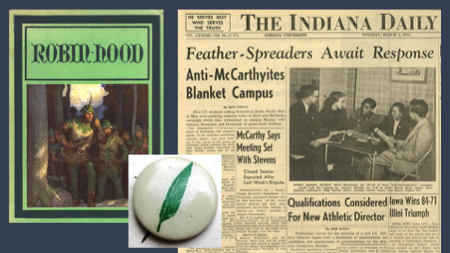
I’d like to share a scene from WALLS, which I admit shedding a few tears as I typed. It features my East Berlin teen, raised in East Germany's communist police-state and anti-America dogma. Despite the dangers and party brainwashing, Matthias still defiantly listens to our music, clandestinely plucking it from the air on a tiny transistor radio he had to position just-so on his apartment windowsill for it to work. His American cousin, Drew, an Army kid stationed with the Berlin Brigade, is visiting—across the then still open border—and Matthias has just shared, with anguish, that he had been summoned to a Selbstkritik. To give “self-criticism” to a tribunal of his peers, who condemned his spending time with Drew, an American capitalist pig. Something that could warrant Matthias being denied going to university or even being sent for “re-education.”
Suddenly, with a mutinous look, Matthias pulls out the bright orange, hand-sized transistor he’d fished out of a trash can on the American Army base when he’d visited Drew. He snaps it on and the sound of AFN and Chubby Checkers’ ‘Pony Time’ crackles into the attic room:
As Chequers’ backup singers pattered in QuickTime boogity boogity boogity shoo—Matthias jumped up and started following the songs instructions: "You turn to the left when I say Gee, you turn to the right when I say Haw."
At first dancing on his shoes to be as quiet as possible, Matthias still gyrated with a recklessness that stunned Drew. It was more than a kid's war dance of defiance. There was a despair in his face, too, that Drew instinctively recognized— the soul-rattling anger and disappointment a teenager feels when his heroes reveal themselves to be full of baloney or even to be villains.
His frenzy growing, Matthias started stomping. “C’mon!” he shouted, laughing wildly. This was dangerously loud, even Drew knew that. Neighbors might hear. For the reward of a few extra food rations, they’d happily report Matthias to the neighborhood brigade of spies—the dreaded spitzel.
But Drew got up and did a rendition of the Twist to keep his cousin company, even though he could tell it was almost as if he wasn't in the room. Matthias was completely absorbed in his own shake, rattle, and roll of disobedience—a reckless, brash musical rebellion.
The song ended. Winded, Drew and Matthias stood panting, grinning, eyeing one another, triumphant and unapologetic, like boys who'd gotten away with a tremendous prank against a cruel headmaster. Then Matthias turned off the radio. Suddenly he looked scared. Really scared.
I knew to write that scene because I had the gift of interviewing several alumni of the Berlin Brigade, “Army brats” during the 1960s who are now in their late '70s. One had convinced AFN to let him and a few of his buddies broadcast a weekly “teen hour” of their favorite hits. After that terrible Wall went up, those American radio boys received a request list, tied around a rock, thrown over the concrete barricade before it was completely outfitted with an impassable no-man’s land. Our teen disc jockeys played that list over and over, hoping the East Berlin kid could hear it. My source learned later that the music-loving East Berlin teen had been arrested by the Stasi (East Germany’s KGB) and disappeared.
All for love of a few songs.
Our State Department continued trying to reach souls trapped behind the Iron Curtain through cultural exchange programming, sending musical groups like Dave Brubeck’s jazz combo into East European countries. The communist regimes carefully controlled who could see those performances, of course, but some East Germans managed to secretly record those concerts. They pressed songs onto old X-ray film they’d pulled out of hospital trash and cut them into 45 rpm-sized circles. Still showing shadowy images of patients’ ribs, lungs, spines.
Think a moment on the wondrous symbolism of American jazz music—the sound of improvisation, the pinnacle of individual, unscripted creativity; jazz’s magical give-and-take between musicians during a live performance; its polyglot amalgamation of diverse, interracial American musical traditions—superimposed over the hearts of people trapped in a country which outlawed such human harmonies and creativity.
Discarded x-rays, circles of sound with edges clearly cut by hand with scissors, keeping the promise of free expression alive.
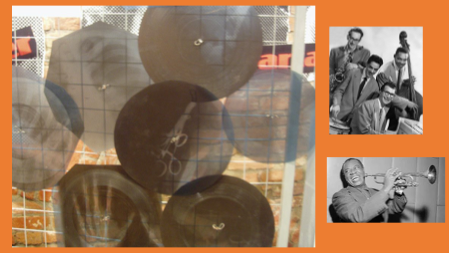
And that’s why power-mongers fear the arts. The arts prompt us to feel, to question, to empathize, to think. And the human soul never stops craving that, even in a police state.
One of the most powerful protests against McCarthyism, by the way, was the play The Crucible. Yes, it's about the Salem witch trials, but Arthur Miller also wrote it to be a poignant wake-up! statement about the fear, mob mentality, and abuse of power he saw all around him during the 1950s Red Scare. Americans who attended his play saw their current political milieu through the prism of those metaphors, allegory, symbols, and ironies intrinsic to the play’s historic plot events. His play was so potent, in fact, the State Department (fearful of McCarthy’s wrath) would rescind Miller’s passport to prevent his sharing such an “anti-American vision” overseas.
But brave theatre companies continued to mount productions of it.
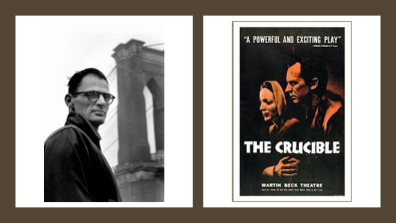
As of yet, there’s no specific organized opposition to what’s happened at the Kennedy Center. If one materializes, I will add a P.S. below.
But here’s what we can do: go to every live arts performance you can elsewhere in Washington, D.C.: to Round House, Arena, Shakespeare, Olney, Next Stop, Wolf Trap, and others. Go to readings of new works. Don’t stop--even if a house comes under fire from MAGA censors because of a progressive--what they'll damn as "woke"-- production. If you stop, you’ll be helping to dim the lights on those stages. Professional artists make their living this way. It’s not just a lark or a hobby or something they can do for free. These champions of ideas, these empaths of the human experience, these commentators on life were already totally upended and financially gutted by COVID shutting them down for months and months and months. We need their insights, their creative bravery, their voices. Subscribe and donate as protest.
One of the first things Trump’s new KenCen regime did was to cancel a planned tour of the children’s musical, Finn, which it commissioned and premiered in 2024. The play is about a young shark who realizes he may relate more to smaller, gentler fishes, a metaphor for children who are “different” finding their way. Could it be about the LGBTQ+ experience? Sure. It could also be about kids with handicaps or high anxiety or learning challenges or weight problems or just quiet, more contemplative personalities.
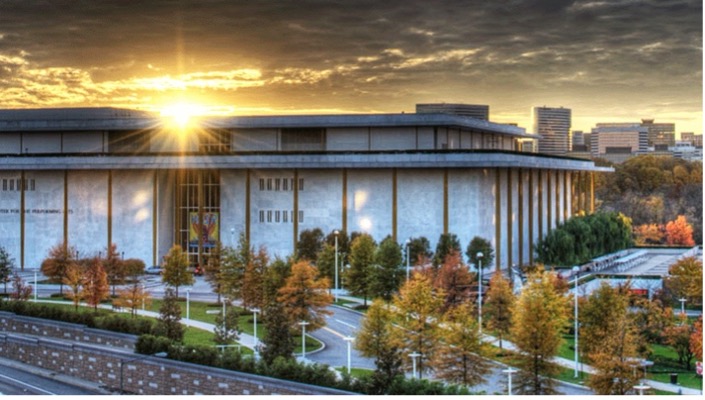

Last week there was a dance protest of Trump’s KenCen coup, including drag performers (artists Trump specifically wanted to purge from the national stage). Maybe someone should also organize a march around the KenCen plaza of children dressed in fish costumes. One of the things we must learn to do in this fight is to fashion protests to point to a specific impact/harm done by Trump/Project 2025/Musk that speaks to a larger, previously unengaged audience. In this case, maybe parents of any child whose personality or body or emotional health may make them a little “different,” who could leave a performance of works like Finn feeling validated, inspired, and better about themselves and the world around them. I suspect there’re millions of parents like that. (To keep up with what happens next with Finn, follow: @finnmusical)
I leave you with a quote from WWII hero, Allied General, and Republican President Dwight Eisenhower—certainly no bleeding-heart or “radical lunatic” to use Trump’s hate label—to use when in conversation with your more conservative friends. He was talking about banned books, but it applies to ALL the arts:
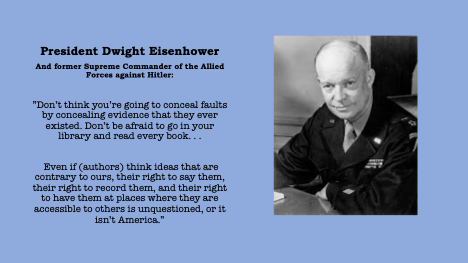

Other Blog Posts
Click Here to See All of Laura's Blog Posts
